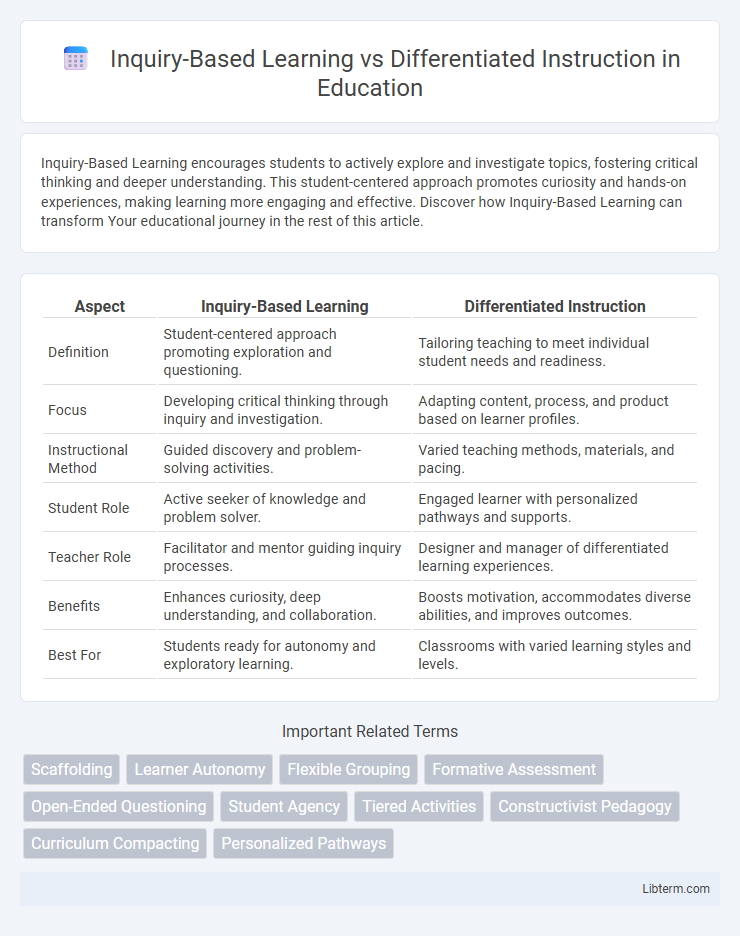Inquiry-Based Learning encourages students to actively explore and investigate topics, fostering critical thinking and deeper understanding. This student-centered approach promotes curiosity and hands-on experiences, making learning more engaging and effective. Discover how Inquiry-Based Learning can transform Your educational journey in the rest of this article.
Table of Comparison
| Aspect | Inquiry-Based Learning | Differentiated Instruction |
|---|---|---|
| Definition | Student-centered approach promoting exploration and questioning. | Tailoring teaching to meet individual student needs and readiness. |
| Focus | Developing critical thinking through inquiry and investigation. | Adapting content, process, and product based on learner profiles. |
| Instructional Method | Guided discovery and problem-solving activities. | Varied teaching methods, materials, and pacing. |
| Student Role | Active seeker of knowledge and problem solver. | Engaged learner with personalized pathways and supports. |
| Teacher Role | Facilitator and mentor guiding inquiry processes. | Designer and manager of differentiated learning experiences. |
| Benefits | Enhances curiosity, deep understanding, and collaboration. | Boosts motivation, accommodates diverse abilities, and improves outcomes. |
| Best For | Students ready for autonomy and exploratory learning. | Classrooms with varied learning styles and levels. |
Understanding Inquiry-Based Learning
Inquiry-Based Learning centers on student-driven exploration, encouraging learners to ask questions, investigate, and construct knowledge through hands-on experiences. This approach promotes critical thinking, curiosity, and deep understanding by allowing students to engage actively with content and develop problem-solving skills. Research shows that Inquiry-Based Learning enhances retention and fosters independent learning, making it effective for diverse educational settings.
Defining Differentiated Instruction
Differentiated instruction is an educational approach that tailors teaching methods, materials, and assessments to accommodate diverse learners' needs, abilities, and interests within a single classroom. It emphasizes personalized learning by modifying content, process, and product based on students' readiness levels and learning profiles. This strategy ensures equitable access to curriculum and fosters student engagement by addressing individual differences effectively.
Core Principles of Inquiry-Based Learning
Inquiry-Based Learning centers on fostering student curiosity through active questioning, investigation, and exploration, promoting deep understanding and critical thinking skills. It emphasizes learner-driven discovery, where students engage in authentic problem-solving tasks and construct knowledge collaboratively. This student-centered approach contrasts with Differentiated Instruction, which primarily focuses on tailoring teaching methods and materials to accommodate diverse learning styles and readiness levels.
Key Components of Differentiated Instruction
Differentiated Instruction centers on tailoring teaching methods to meet diverse student needs through flexible content, process, and product variations. Key components include ongoing assessment to identify learners' readiness levels, interests, and learning profiles, enabling customized tasks that promote engagement and understanding. This approach contrasts with Inquiry-Based Learning by emphasizing targeted adaptation rather than student-driven question formulation.
Comparing Educational Goals
Inquiry-Based Learning prioritizes fostering critical thinking and problem-solving skills by encouraging students to explore questions and discover knowledge independently. Differentiated Instruction aims to meet diverse learner needs by tailoring content, process, and product according to students' readiness, interests, and learning profiles. Both approaches seek to enhance student engagement and achievement but differ in focus: Inquiry-Based Learning centers on cultivating inquiry skills, while Differentiated Instruction emphasizes personalized support for individual learning differences.
Teacher Roles in Both Approaches
In Inquiry-Based Learning, teachers act as facilitators, guiding students through open-ended questions and encouraging critical thinking and exploration. In Differentiated Instruction, teachers take on the role of designers, tailoring lessons and assessments to meet diverse learning needs and abilities within the classroom. Both approaches emphasize the teacher's adaptability to support student-centered learning and maximize individual growth.
Impact on Student Engagement
Inquiry-based learning fosters active student participation by encouraging curiosity and critical thinking, increasing engagement through exploration and problem-solving. Differentiated instruction boosts engagement by tailoring content, process, and product to meet diverse learner needs and preferences, ensuring all students remain motivated and challenged. Both approaches enhance student involvement but target engagement through different mechanisms--discovery-driven interaction versus personalized learning experiences.
Assessment Strategies: Inquiry vs Differentiation
Inquiry-Based Learning employs formative assessments that emphasize students' problem-solving processes and critical thinking skills, utilizing open-ended questions and reflective journals to gauge understanding. Differentiated Instruction incorporates varied assessment methods tailored to individual learning styles and readiness levels, such as tiered assignments and performance tasks, ensuring each student's progress is accurately measured. Both strategies prioritize ongoing assessment to inform instruction but diverge in focusing either on exploration and discovery (Inquiry) or personalized learning needs (Differentiation).
Advantages and Challenges
Inquiry-Based Learning promotes critical thinking and deep understanding by encouraging students to explore questions and solve problems independently, fostering engagement and motivation; however, it requires significant teacher training and may challenge students who struggle with open-ended tasks. Differentiated Instruction tailors teaching strategies to meet diverse learner needs, improving accessibility and academic success for varied skill levels, but it demands extensive planning and ongoing assessment to effectively manage multiple learning paths. Both approaches enhance personalized learning but necessitate balancing resource allocation and instructional flexibility to optimize outcomes.
Choosing the Right Approach for Your Classroom
Inquiry-Based Learning promotes student-driven exploration, encouraging critical thinking and problem-solving by engaging learners in questioning and investigation. Differentiated Instruction tailors teaching strategies and content to meet diverse student needs, learning styles, and readiness levels for personalized educational experiences. Selecting the right approach depends on classroom goals, student variability, and subject matter complexity to enhance engagement and learning outcomes effectively.
Inquiry-Based Learning Infographic

 libterm.com
libterm.com